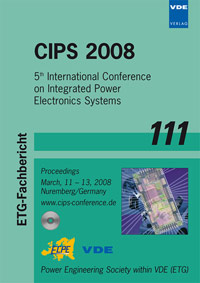Extraction of Efficient Thermal Models for Life Limiting Interfaces in Power Modules
Conference: CIPS 2008 - 5th International Conference on Integrated Power Electronics Systems
03/11/2008 - 03/13/2008 at Nuremberg, Germany
Proceedings: CIPS 2008
Pages: 5Language: englishTyp: PDF
Personal VDE Members are entitled to a 10% discount on this title
Authors:
Musallam, Mahera; Johnson, C. Mark (University of Nottingham, Power Electronics and Control Group, School of Electrical and Electronic Engineering, University Park, Nottingham, NG7 2RD, UK)
Abstract:
Health assessment and thermal management play a key role in reliability modelling of power electronic devices. In practice, electronic devices are subjected to pulsed power dissipation under variable operating conditions, so the temperatures of the semiconductor junctions and associated packaging vary continually. In principle, junction temperature-time information can be used to drive a reliability model, for example it can be used to determine wire bond life, which is largely governed by die temperature. However, for interfaces away from the surface, such as solder layers, measurement of temperature is difficult and therefore direct determination of the thermal parameters for the solder layers and other hidden layers within the module’s package is impracticable. In this paper an alternative approach is presented. A validated FLOTHERM model is developed to predict the temperatures of the solder layers and other hidden layers within the module. The thermal parameters of the heat transfer path from any heat source (die) to the hidden layer were determined using the predicted values from the FLOTHERM model rather than direct measurements. The FLOTHERM model is validated using measurable surface temperatures, for example at junctions and the baseplate. Results are presented showing the application of the model under a range of power cycling conditions.


